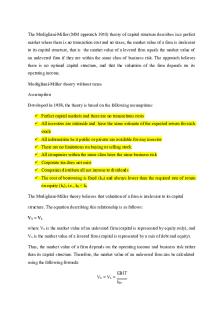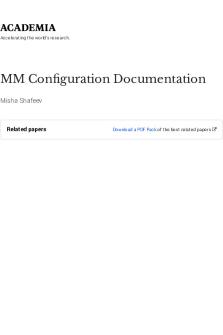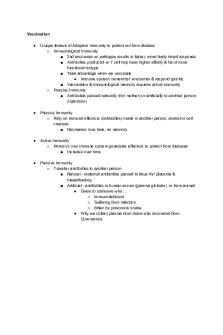Moorov Doctrine MM PDF

| Title | Moorov Doctrine MM |
|---|---|
| Author | lauren Frame |
| Course | EVIDENCE |
| Institution | University of Aberdeen |
| Pages | 1 |
| File Size | 221.6 KB |
| File Type | |
| Total Downloads | 23 |
| Total Views | 137 |
Summary
The moorov doctrine and its history summarised using lecture and case notes in the form of a mind map. ...
Description
Provides
limited to pairs of charges and to charges on the same indictment
that the evidence of one witness (Witness A) in a case of criminal conduct forming part of a series of two or more instances of criminal conduct may be capable of providing corroboration for the evidence of a witness (Witness B) in another case/ cases closely connected in time/ character/circumstance and where an underlying unity can be proven
Limitations
wider doctrine of 'similar fact evidence' prevails in UK
authority for the proposition that corroboration of one charge (A) may be found in evidence of another, similar, charge (B) even with no positive identification of the accused in relation to charge A jury is able to find that the two offences must have been committed by the same person, and there is corroborated evidence of identity in relation to charge B
Lord Justice-General Clyde
the test I think is whether the evidence of a single witness leads by necessary inference to the establishment of some circumstances or state of fact underlying and connecting several charges
Howden v HMA 1994 Moorov Doctrine What is the test of sufficiency? (for mutual corroboration)
where there is similarities between A and B judicial interpretation of Moorov remains uncertain
noted there is authority which suggests that Moorov may only operate where there are at least two live charges remaining on the indictment the evidence relating to charges of which the accused has been acquitted must be left out of account
if it had been independently established, would have afforded corroboration of the evidence given by the single witnesses in support of the separate charged the connection between the separate acts must be such as to exhibit them as subordinates in some particular and ascertained unity of intent
PM v HMA 2011
read in conjunction with RG v HMA
court JL v HMA 2016
there is no maximum interval of time fixed by law beyond which the Moorov principle cannot apply the probative effect of a significant time gap can only be determined in light of the circumstances of the case the more similar the conduct the less important a significant time gap may be Time, character & circumstance
the evidence must be such as to show the events are linked in such a way as to justify the conclusion that each is com-
AK v HM Advocate 2012 Lord Justice Clerk Gill
AS v HM Advocate 2015, Lord Justice Clerk Carloway
AS v HM Advocate
not enough that the events constitute isolated instances of similar conduct MR v HMA 2013...
Similar Free PDFs

Moorov Doctrine MM
- 1 Pages

MAKALAH mm
- 13 Pages

MM Theory
- 8 Pages

MM WA1
- 6 Pages

Sap mm tutorial - Note for SAP MM
- 39 Pages

MM-LAB5 - Nota: a+
- 13 Pages

MM Configuration Documentation
- 88 Pages

Tutorial MM questions only
- 2 Pages

Cypres Doctrine
- 8 Pages

MM Exam 4 Notes
- 16 Pages

MM ASL - ASLA
- 2 Pages

Apuntes de Teo MM
- 78 Pages

Alphazero preprint - mm
- 32 Pages

MM 3° Segundo trimestre
- 81 Pages

Doctrine Of Severability
- 1 Pages

Doctrine of Repugnancy
- 5 Pages
Popular Institutions
- Tinajero National High School - Annex
- Politeknik Caltex Riau
- Yokohama City University
- SGT University
- University of Al-Qadisiyah
- Divine Word College of Vigan
- Techniek College Rotterdam
- Universidade de Santiago
- Universiti Teknologi MARA Cawangan Johor Kampus Pasir Gudang
- Poltekkes Kemenkes Yogyakarta
- Baguio City National High School
- Colegio san marcos
- preparatoria uno
- Centro de Bachillerato Tecnológico Industrial y de Servicios No. 107
- Dalian Maritime University
- Quang Trung Secondary School
- Colegio Tecnológico en Informática
- Corporación Regional de Educación Superior
- Grupo CEDVA
- Dar Al Uloom University
- Centro de Estudios Preuniversitarios de la Universidad Nacional de Ingeniería
- 上智大学
- Aakash International School, Nuna Majara
- San Felipe Neri Catholic School
- Kang Chiao International School - New Taipei City
- Misamis Occidental National High School
- Institución Educativa Escuela Normal Juan Ladrilleros
- Kolehiyo ng Pantukan
- Batanes State College
- Instituto Continental
- Sekolah Menengah Kejuruan Kesehatan Kaltara (Tarakan)
- Colegio de La Inmaculada Concepcion - Cebu